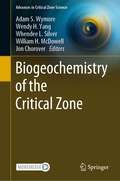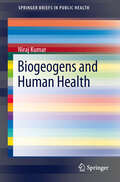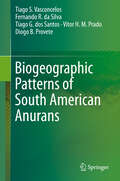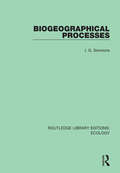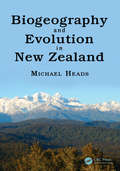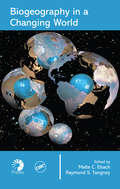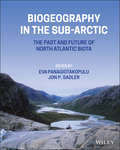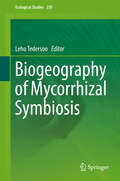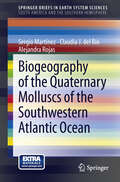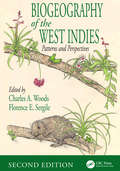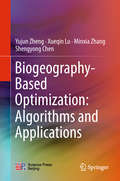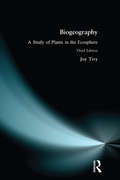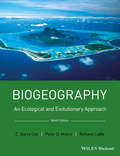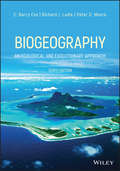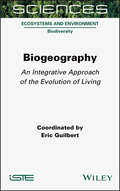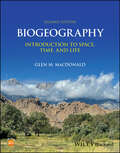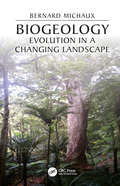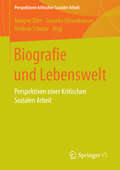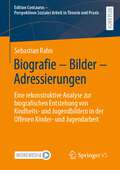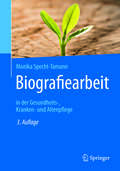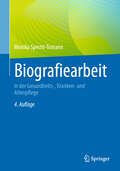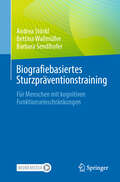- Table View
- List View
Biogeochemistry of the Critical Zone (Advances in Critical Zone Science)
by William H. McDowell Adam S. Wymore Wendy H. Yang Whendee L. Silver Jon ChoroverThis book highlights recent advances in the discipline of biogeochemistry that have directly resulted from the development of critical zone (CZ) science. The earth's critical zone (CZ) is defined from the weathering front and lowest extent of freely circulating groundwater up through the regolith and to the top of the vegetative canopy. The structure and function of the CZ is shaped through tectonic, lithologic, hydrologic, climatic, and biological processes and is the result of processes occurring at multiple time scales from eons to seconds. The CZ is an open system in which energy and matter are both transported and transformed. Critical zone science provides a novel and unifying framework to consider those coupled interactions that control biogeochemical cycles and fluxes of energy and matter that are critical to sustaining a habitable planet. Biogeochemical processes are at the heart of energy and matter fluxes through ecosystems and watersheds. They control the quantity and quality of carbon and nutrients available for living organisms, control the retention and export of nutrients affecting water quality and soil fertility, and influence the ability for ecosystems to sequester carbon. As the term implies, biogeochemical cycles, and the rates at which they occur, result from the interaction of biological, chemical, and physical processes. However, finding a unifying framework by which to study these interactions is challenging, and the different components of bio-geo-chemistry are often studied in isolation. The authors provide both reviews and original research contributions with the requirement that the chapters incorporate a CZ framework to test biogeochemical theory and/or develop new and robust predictive models regarding elemental cycles. The book demonstrates how the CZ framework provides novel insights into biogeochemistry.
Biogeogens and Human Health (SpringerBriefs in Public Health)
by Niraj KumarHealth of the people is the most important indicator of the development of a nation. Health is a state of complete physical, mental and social well being and not merely the absence of disease or infirmity (as defined by WHO). The state of health of an individual or population depends upon complex interaction of the physical, biological, political and social domains. The environment affects the human health in a big way. People tend to be most susceptible to illness when physically or mentally stressed. Stress, energy and immunity form a closely knit network. Through his experimental findings, the author has brought out this intricate concept of interdependence of biotic (living) and abiotic (non-living) factors in an ecosystem, resulting in an impact on human health, in an explicitly marvelous manner. As a result, a new word "Biogeogens" has been coined, "bio" for living (biotic) , "geo" for non-living (abiotic/geographical/climatic/environment) and "gens" for the interactive proceeds of the two. The content included herein is directly concerned with the societal health and gives a clue to many socio-psycho health problems presently not handled with care. It also defines a multidimensional approach for dealing with many psychosomatic and health problems.
Biogeographic Patterns of South American Anurans
by Tiago S. Vasconcelos Fernando R. da Silva Tiago G. dos Santos Vitor H. Prado Diogo B. ProveteThis book analyzes different facets of anuran amphibian distribution in South America. We integrate alternative biological metrics employing cutting-edge methods to understand the dynamic processes underlying species distribution patterns. By using the modern biogeographic toolbox, we explore how richness gradients, phylogenetic diversity, functional diversity, and range size/endemism distribution of amphibians vary along the continent. Moreover, we present a robust proposal for priority areas for conservation of anurans in South America that maximizes representativeness of distinct biodiversity facets.
Biogeographical Processes (Routledge Library Editions: Ecology #11)
by I. G. SimmonsOriginally published in 1982, Biogeographical Processes is a concise introduction to biogeography aimed at undergraduate students. It provides a detailed overview of man and his environment and includes data from such research projects as that of the International Biological Programme. The book argues that natural processes can be viewed as a datum line to which the human impact through time is added. It suggests that through this datum line, the man and the biological environment are inextricably linked. The book firstly examines the fundamental processes determining the distribution of plants and animals, and the interactions between such processes leading to the concept of the ecosystem. The book also examines major world ecosystems, or biomes, such as forests, grasslands and oceans as if they were in a natural condition and discusses the affect of human impact upon such systems. The book also discusses the alternative future relationships of man and other living organisms. Although over 30 years old, the book still contains a useful and detailed overview of biogeography. It will be of interest to students or lecturers in ecology, biology and the environmental sciences.
Biogeography and Biodiversity of Western Atlantic Mollusks
by Edward J. PetuchShallow water marine molluscan faunas are distributed in a pattern of distinct, geographically definable areas. This makes mollusks ideal for studying the distribution of organisms in the marine environment and the processes and patterns that control their evolution. Biogeography and Biodiversity of Western Atlantic Mollusks is the first book to us
Biogeography and Evolution in New Zealand (CRC Biogeography Series #1)
by Michael HeadsBiogeography and Evolution in New Zealand provides the first in-depth treatment of the biogeography of New Zealand, a region that has been a place of long-enduring interest to ecologists, evolutionary scientists, geographers, geologists, and scientists in related disciplines. It serves as a key addition to the contemporary discussion on regionalization—how is New Zealand different from the rest of the world? With what other areas does it share its geology, history, and biota? Do new molecular phylogenies show that New Zealand may be seen as a biological ‘parallel universe’ within global evolution?
Biogeography in a Changing World
by Malte C. Ebach Raymond S. TangneyHampered by a confusing plethora of approaches and methods, biogeography is often treated as an adjunct to other areas of study. The first book to fully define this rapidly emerging subdiscipline, Biogeography in a Changing World elucidates the principles of biogeography and paves the way for its evolution into a stand-alone field.Drawin
Biogeography in the Sub-Arctic: The Past and Future of North Atlantic Biotas
by Eva Panagiotakopulu Jon P SadlerThere is no escaping the fact that the island biogeography of the North Atlantic Region is singularly peculiar. Sitting in the north of the Atlantic Ocean, these islands have been subjected to largescale shifts in climate over the last few million years, unlike the other island groups further south which were likely more buffered from the vicissitudes of Quaternary climate changes. Uniquely for a group of islands there is only one documented extinction in the North Atlantic (the Great Auk), and those in the insects are local events relating to species that are distributed throughout the Palaearctic region. Over half the insect species in Iceland and Greenland are introduced. The faunas, excluding Greenland, are predominantly of Palaearctic origin and have close affinities with the faunas of Scandinavia and the British Isles and. These unique physical and biological characteristics have interested biologists and biogeographers for centuries. The key debates concerning the biogeography of the North Atlantic islands still rumble on: Do the biota reflect cryptic refugia or otherwise, or tabula rasa and recolonization? How important were human communities in shaping the existing biota and biogeographical patterns? Throw into this mix current concerns over global warming, and we can now ask, how resilient is the biota to change, either natural or anthropogenic? This volume draws together a range of researchers with longstanding research interests in the region, from diverse academic backgrounds, to evaluate some of these questions.
Biogeography of Australasia
by Michael HeadsOver the last decade, molecular studies carried out on the Australasian biota have revealed a new world of organic structure that exists from submicroscopic to continental scale. Furthermore, in studies of global biogeography and evolution, DNA sequencing has shown that many large groups, such as flowering plants, passerine birds and squamates, have their basal components in this area. Using examples ranging from kangaroos and platypuses to kiwis and birds of paradise, the book examines the patterns of distribution and evolution of Australasian biodiversity and explains them with reference to tectonic and climatic change in the region. The surprising results from molecular biogeography demonstrate that an understanding of evolution in Australasia is essential for understanding the development of modern life on Earth. A milestone in the literature on this subject, this book will be a valuable source of reference for students and researchers in biogeography, biodiversity, ecology and conservation.
Biogeography of Mycorrhizal Symbiosis (Ecological Studies #230)
by Leho TedersooThis book offers a timely overview and synthesis of biogeographic patterns of plants and fungi and their mycorrhizal associations across geographic scales. Written by leading experts in the field, it provides an updated definition of mycorrhizal types and establishes the best practices of modern biogeographic analyses. Individual chapters address the basic processes and mechanisms driving community ecology, population biology and dispersal in mycorrhizal fungi, which differ greatly from these of prokaryotes, plants and animals. Other chapters review the state-of-the-art knowledge about the distribution, ecology and biogeography of all mycorrhizal types and the most important fungal groups involved in mycorrhizal symbiosis. The book argues that molecular methods have revolutionized our understanding of the ecology and biogeography of mycorrhizal symbiosis and that rapidly evolving high-throughput identification and genomics tools will provide unprecedented information about the structure and functioning of mycorrhizal symbiosis on a global scale. This volume appeals to scientists in the fields of plant and fungal ecology and biogeography.
Biogeography of the Quaternary Molluscs of the Southwestern Atlantic Ocean (SpringerBriefs in Earth System Sciences)
by Sergio Martínez Claudia J. del Río Alejandra RojasThe Quaternary comprises a brief time in the Earth's history, and apart from a few exceptions, molluscan assemblages recovered from exposures along the coast of Southwestern South America (Southern Brazil, Uruguay, Argentina) are essentially the same than those that inhabit the region today, leading to the assumption that no important change in the distribution of the faunas since Pleistocene times has occurred. However, the good taxonomic and temporal resolution reached in the last years, allowed us to detect some biogeographic changes, although traditional biogeographic units remain the same (i.e. Magellanic and Argentinean Provinces). These modifications involve mainly variations in the taxonomic composition of the assemblages and in the southern boundaries of some species distributions (extralimital species), today retracted northwards. These changes are related to southward shifts of the warm waters of the Brazilian Current, correlated with global warm peaks. This phenomenon was more intense in the Late Pleistocene (MIS 5e) and in the Holocene between ca. 6500-3500 14C yr.
Biogeography of the West Indies: Patterns and Perspectives, Second Edition
by Charles A. Woods Florence E. SergileAs a review of the status of biogeography in the West Indies in the 1980s, the first edition of Biogeography of the West Indies: Past, Present, and Future provided a synthesis of our current knowledge of the systematics and distribution of major plant and animal groups in the Caribbean basin. The totally new and revised Second Edition, Biogeography
Biogeography-Based Optimization: Algorithms and Applications
by Yujun Zheng Xueqin Lu Minxia Zhang Shengyong ChenThis book introduces readers to the background, general framework, main operators, and other basic characteristics of biogeography-based optimization (BBO), which is an emerging branch of bio-inspired computation. In particular, the book presents the authors’ recent work on improved variants of BBO, hybridization of BBO with other algorithms, and the application of BBO to a variety of domains including transportation, image processing, and neural network learning. The content will help to advance research into and application of not only BBO but also the whole field of bio-inspired computation. The algorithms and applications are organized in a step-by-step manner and clearly described with the help of pseudo-codes and flowcharts. The readers will learn not only the basic concepts of BBO but also how to apply and adapt the algorithms to the engineering optimization problems they actually encounter.
Biogeography: A Study of Plants in the Ecosphere
by Joy TivyThe third edition of this classic text, presents a broad-based study of the variations in the form and functioning of the biosphere at regional and global scale.
Biogeography: An Ecological and Evolutionary Approach
by Barry Cox Peter D. MooreThrough eight successful editions, and over nearly 40 years, Biogeography: An Ecological and Evolutionary Approach has provided a thorough and comprehensive exploration of the varied scientific disciplines and research that are essential to understanding the subject. The text has been praised for its solid background in historical biogeography and basic biology, that is enhanced and illuminated by discussions of current research.This new edition incorporates the exciting changes of the recent years, and presents a thoughtful exploration of the research and controversies that have transformed our understanding of the biogeography of the world. It also clearly identifies the three quite different arenas of biogeographical research: continental biogeography, island biogeography and marine biogeography. It is the only current textbook with full coverage of marine biogeography. It reveals how the patterns of life that we see today have been created by the two great Engines of the Planet - the Geological Engine, plate tectonics, which alters the conditions of life on the planet, and the Biological Engine, evolution, which responds to these changes by creating new forms and patterns of life.
Biogeography: An Ecological and Evolutionary Approach
by Richard J. Ladle Peter D. Moore C. Barry CoxThrough nine successful editions, and for over 45 years, Biogeography: An Ecological and Evolutionary Approach has provided a thorough and comprehensive exploration of the varied scientific disciplines and research that are essential to understanding the subject. The text, noted for its clear and engaging style of writing, has been praised for its solid background in historical biogeography and basic biology, that is enhanced and illuminated by discussions of current research. This new edition incorporates the exciting changes of the recent years and presents a thoughtful exploration of the research and controversies that have transformed our understanding of the biogeography of the world. New themes and topics in this tenth edition include: Next generation genetic technologies and their use in historical biogeography, phylogeography and population genomics Biogeographical databases and biodiversity information systems, which are becoming increasingly important for biogeographical research An introduction to functional biogeography and its applications to community assembly, diversity gradients and the analysis of ecosystem functioning Updated case studies focusing on island biogeography, using the latest phylogenetic studies Biogeography: An Ecological and Evolutionary Approach reveals how the patterns of life that we see today have been created by the two great Engines of the Planet: the Geological Engine, plate tectonics, which alters the conditions of life on the planet, and the Biological Engine, evolution, which responds to these changes by creating new forms and patterns of life.
Biogeography: An Integrative Approach of the Evolution of Living
by Eric GuilbertThe recent progress in analytical methods, aided by bringing in a wide range of other disciplines, opens up the study to a broader field, which means that biogeography now goes far beyond a simple description of the distribution of living species on Earth.Originating with Alexander von Humboldt, biogeography is a discipline in which ecologists and evolutionists aim to understand the way that living species are organized in connection with their environments. Today, as we face major challenges such as global warming, massive species extinction and devastating pandemics, biogeography offers hypotheses and explanations that may help to provide solutions.This book presents as wide an overview as possible of the different fields that biogeography interacts with. Sixteen authors from all over the world offer different approaches based on their specific areas of knowledge and experience; thus, we intend to illustrate the vast number of diverse aspects covered by biogeography.
Biogeography: Biological Diversity across Space and Time
by Robert J. Whittaker Mark V. Lomolino Brett R. RiddleBiogeography, Fifth Edition, is written as a primary text for undergraduate and graduate courses, and is also an invaluable reference for biogeographers, ecologists, evolutionary biologists, and conservation biologists. Its fundamental assertion is that patterns in biological diversity make little sense unless viewed within an explicit geographic context. Starting from principal patterns and fundamental principles, and assuming only a rudimentary knowledge of biology, geography, and Earth history, the text explains the relationships between geographic variation in biological diversity and the geological, ecological, and evolutionary processes that have produced them.
Biogeography: Introduction to Space, Time, and Life
by Glen M. MacDonaldIntroduce students to the diversity embraced by the discipline of biogeography, revised and updated throughout Biogeography: Space, Time and Life provides a comprehensive introduction to the study of large-scale geographic distributions of life, focusing on ecology, evolution, physical geography and conservation. Now in its second edition, this award-winning textbook illustrates key concepts in biogeography using engaging empirical examples of modern plant and animal distributions, long-term evolutionary history and current conservation challenges. With an accessible style and clear structure, Biogeography defines fundamental terms from biology and physical geography, describes ecological biogeography and the biological features of the physical environment, explains key concepts in historical biogeography, explores the Earth’s diverse biogeographic subdivisions, current issues in conservation and more. Student-friendly chapters cover topics including biological interactions, speciation and extinction, changing continents and climates, human evolution, modern biodiversity, the relationship between humans and plants, animals and other organisms, and the role of biogeography in conservation. Introduces basic concepts in the study of animal and vegetation distributions, including various human and environmental impacts on these distributions Examines how biological factors such as heat and predation impact different species of plants and animals Features short biographical sketches of major figures in the field and examples of the natural histories of various species Considers the application of biogeographic theory and techniques for the benefit of conservation and sustainability Includes a companion website for students, as well as an instructor’s site with supplementary teaching resourcesDesigned for students across a wide range of disciplines, from the biological and physical sciences to the social sciences and humanities, Biogeography: Space, Time and Life, Second Edition is an excellent textbook for undergraduate courses in biogeography, Earth systems science, and environmental studies.
Biogeology: Evolution in a Changing Landscape (CRC Biogeography Series)
by Bernard MichauxThis detailed exposition gives background and context to how modern biogeography has got to where it is now. For biogeographers and other researchers interested in biodiversity and the evolution of life on islands, Biogeology: Evolution in a Changing Landscape provides an overview of a large swathe of the globe encompassing Wallacea and the western Pacific. The book contains the full text of the original article explored in each chapter, presented as it appeared on publication. Key features: Holistic treatment, collecting together a series of important biogeographical papers into a single volume Authored by an expert who has spent nearly three decades actively involved in biogeography Describes and interprets a region of exceptional biodiversity and extreme endemism The only book to provide an integrated treatment of Wallacea, Melanesia, New Zealand, the New Zealand Subantarctic Islands and Antarctica Offers a critique of fashionable neo-dispersalist arguments, showing how these still suffer from the same weaknesses of the original Darwinian formulation. The chapters also include analysis of many major theoretical and philosophical issues of modern biogeographic theory, so that those interested in a more philosophical approach will find the book stimulating and thought-provoking.
Biografie und Lebenswelt: Perspektiven einer Kritischen Sozialen Arbeit (Perspektiven kritischer Sozialer Arbeit #20)
by Margret Dörr Cornelia Füssenhäuser Heidrun SchulzeBiografie und Lebenswelt gelten als zentrale Fachbegriffe innerhalb der Sozialen Arbeit, die gleichermaßen für Theorie, Praxis und Forschung bedeutsam sind. In theoretischer und empirischer Weise werden in dem Sammelband die theoretischen Zugänge zu Biografie und Lebenswelt in unterschiedlichen Positionierungen hinsichtlich ihres Potentials für eine Kritische Soziale Arbeit diskutiert und aufgeschlossen. Weitere Fragen in diesem Spektrum lauten: In welcher Weise haben unterschiedliche und möglicherweise auch konkurrierende Perspektiven auf Lebenswelt und Biografie (oftmals unreflektiert) Einfluss auf die Rekonstruktion sozialer Wirklichkeiten? Wie kann Forschung - als ein machtvoller intersubjektiver Prozess - betrachtet werden - und wie können hierbei auch die selbsterzeugten Blindstellen Sozialer Arbeit in den Fokus genommen werden?
Biografie – Bilder – Adressierungen: Eine rekonstruktive Analyse zur biografischen Entstehung von Kindheits- und Jugendbildern in der Offenen Kinder- und Jugendarbeit (Edition Centaurus - Perspektiven Sozialer Arbeit in Theorie und Praxis)
by Sebastian RahnVorstellungen darüber, was Kindheit und Jugend sind und welche Rahmenbedingungen ein ‚gutes‘ Aufwachsen benötigt, sind für die Pädagogik und damit auch für die Offene Kinder- und Jugendarbeit konstitutiv. Die vorliegende Studie untersucht, wie mentale Kindheits- und Jugendbilder bei Fachkräften in der offenen Arbeit biografisch entstehen und wie hierbei eigene Erfahrungen im Aufwachsen, Professionalisierungsprozesse und gesellschaftliche Leitbilder zusammenwirken. Zudem wird die Bedeutung dieser biografisch akkumulierten Bilder für die Adressierungspraktiken der Fachkräfte analysiert. Insbesondere in dem von diffusen Aufgaben- bzw. Funktionszuschreibungen geprägten Arbeitsfeld der Offenen Kinder- und Jugendarbeit haben biografische Wissens- und Erfahrungsbestände der Fachkräfte eine hohe Relevanz für die berufliche Praxis. Ziel der Untersuchung ist es, diesen spezifischen Aspekt der Ermöglichungsbedingungen der offenen Arbeit zu rekonstruieren und darüber zu einem tieferen Verständnis des Verhältnisses von normativen arbeitsfeldspezifischen Leitorientierungen und Postulaten (z.B. Offenheit, Freiheit, Partizipativität) auf der einen sowie biografisch entstandenen Dispositionen auf der anderen Seite zu gelangen.
Biografiearbeit: in der Gesundheits-, Kranken- und Altenpflege
by Monika Specht-TomannBiografiearbeit ist ein Instrument in der Kranken- und Altenpflege, mit dem der Blick für das Leben der Patienten bzw. der Bewohner geschärft und der ganzheitliche Zugang zu ihren Bedürfnissen erleichtert wird. Fähigkeiten von Alten und Kranken werden durch Biografiearbeit aktiviert und verbessert. Das Buch ist mit zahlreichen Anleitungen zur Umsetzung der verschiedenen Methoden und mit vielen Beispielen aus der Pflege- und Betreuungspraxis eine Unterstützung für alle, die mit alten und kranken Menschen arbeiten.
Biografiearbeit: in der Gesundheits-, Kranken- und Altenpflege
by Monika Specht-TomannDieses Buch zeigt Pflegenden, Ehrenamtlichen und Begleitenden die vielfältigen Methoden der Biografiearbeit zur Unterstützung der Ressourcen kranker, alter und sterbender Menschen. Anhand wertvoller Tipps, alltäglichen Fallbeispielen und konkreten Ansätzen, lernen Sie, wie Sie Betroffene mit ihrer Lebensgeschichte besser begleiten und pflegen können.
Biografiebasiertes Sturzpräventionstraining: Für Menschen mit kognitiven Funktionseinschränkungen
by Andrea Stöckl Bettina Wallmüller Barbara SendlhoferDieses Praxisbuch deckt sämtliche Aspekte der biografiebasierten Therapie im Kontext des Sturzpräventionstrainings für die Bereiche Ergotherapie und Physiotherapie ab. Die Therapie wurde gezielt für Personen mit leichten bis mittelschweren kognitiven Funktionseinschränkungen entwickelt. Im Fokus der therapeutischen Arbeit stehen die Bedeutung von Beziehung, die Kommunikation und die Gestaltung der Umgebung. Dies gilt besonders im Zusammenhang mit dementiellen Erkrankungen sowie bei Krankheitsbildern wie Multipler Sklerose und Parkinson. Um diese Ansätze in die Praxis umzusetzen, werden die Struktur einer Therapiesitzung, Kommunikationstechniken, die Bedeutung von Symbolen und der Umgang mit herausfordernden Situationen ausführlich erläutert. Aus dem Inhalt: Therapieplanung und Durchführung mit Intensität, Dauer und Frequenz, Befunderhebung, Assessments und Zielformulierungen nach ICF, Gleichgewichtstraining und Krafttraining, Praxisbeispiele für die Rehabilitation, die Langzeitbetreuung und das extramurale Setting.
